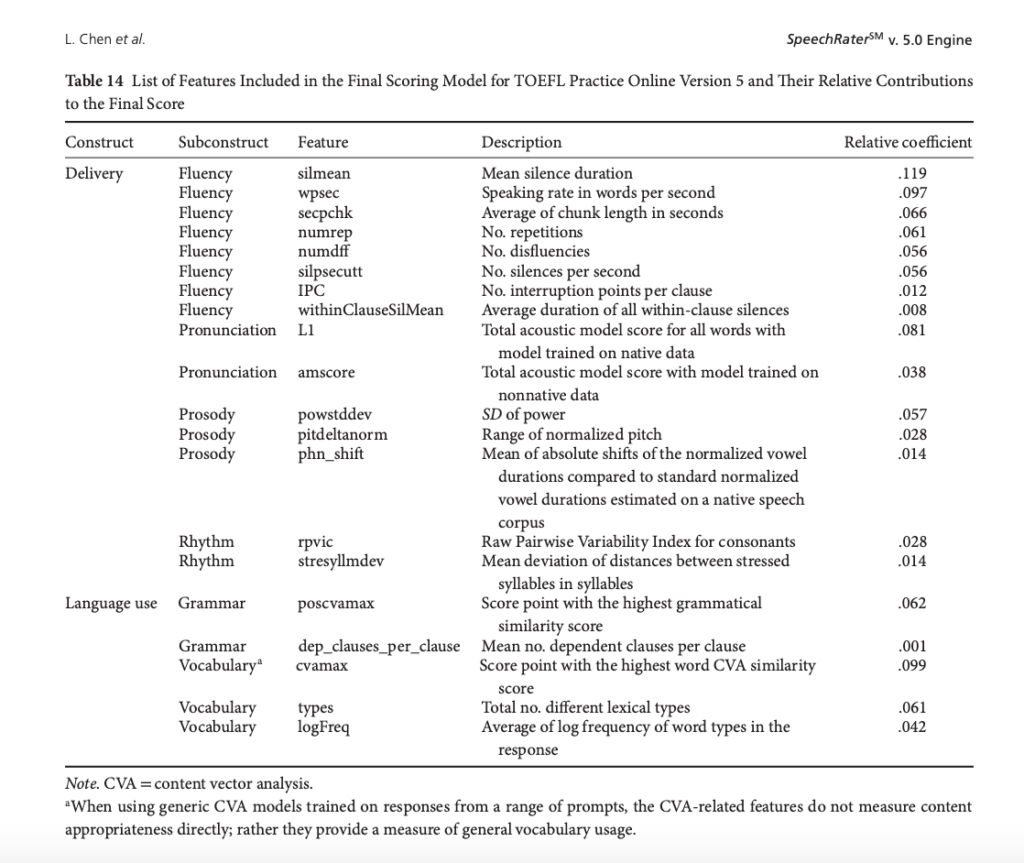Answering TOEFL speaking questions can be challenging, but with the right approach and a well-structured template, you can boost your confidence and enhance your performance. In this blog, we’ll guide you through a proven “How to” format to effectively use a speaking template for all four speaking tasks in the TOEFL exam. A structured template will significantly bolster your confidence and performance during this critical part of the test.
Moreover, we’ll teach you how to master note-taking alongside the templates, enabling you to compose well-structured answers more effortlessly. Let’s dive in and equip you with the tools for TOEFL speaking success!
Table of contents
Understanding the Importance of Speaking Templates
A speaking template serves as a framework to structure your responses coherently. It helps organize your thoughts, keeps your answers on track, and ensures you cover all essential aspects of each speaking task, leading to more polished and impressive responses.
- Understand the Template and Introduction
Firstly, familiarize yourself with the TOEFL speaking template, which includes an introduction, main points, supporting details, and a conclusion. Start your response with a brief introduction that clearly states the topic or provides context for the task. This will set the tone for your answer and let the evaluator know your stance.
- Analyze Sample Questions and Incorporate Main Points
Next, practice with sample TOEFL speaking questions. Analyze the questions to identify the main topic and key instructions. Incorporate 2-3 main points that directly support your position or answer the given question. These main points will serve as the backbone of your response.
- Note-Taking Using the Template and Supporting Details
During the preparation time, take notes using the template structure. Write down a clear introduction that addresses the topic and your stance. Then, jot down 2-3 main points that directly relate to the question. For each main point, add supporting details or examples to illustrate and strengthen your arguments. Specific examples will showcase your language proficiency and critical thinking skills.
- Compose Your Response and the Conclusion
Now, use the notes you took with the template to compose your answer. Start with the introduction, confidently stating the topic and your position. Then, smoothly transition to each main point, supporting them with the corresponding details from your notes. Wrap up your response by summarizing your main points and restating your position or opinion in the conclusion. This will create a cohesive and memorable answer for the evaluator.
- Practice with Different Tasks
To master the template, practice with various TOEFL speaking tasks. The more you practice, the more comfortable and proficient you’ll become in using the template effectively.
- Seek Feedback and Improvement
Seek feedback from a TOEFL tutor or study partner. Constructive criticism can help you identify areas for improvement and fine-tune your template-based responses.
- Conclusion
Using a well-structured template can be a game-changer in how you approach TOEFL speaking questions. By following these steps and practicing regularly, you’ll be well-equipped to confidently tackle any speaking task and maximize your score on the TOEFL exam. Best of luck on your TOEFL journey!
How to Create Your TOEFL Speaking Templates
Before we dive into creating templates for each speaking task, let’s follow these steps to design effective templates:
Step 1: Familiarize Yourself with the Speaking Tasks
Thoroughly understand the different types of speaking tasks in the TOEFL exam, including the independent and integrated tasks. This knowledge will be the foundation of your templates.
Step 2: Analyze Sample Responses
Study high-scoring sample responses available in official TOEFL resources or online. Pay attention to the structure, vocabulary, and language used in these responses. Observe how speakers introduce their answers, provide supporting details, and conclude their responses.
Step 3: Design Your Template Structure
Based on your analysis of sample responses, design flexible and adaptable templates for each speaking task. Ensure your templates include an introduction, main points, supporting details, and a conclusion.
Template Structure
TOEFL Speaking Template: Task 1
Speaking Task 1: Independent Speaking
| Section | Description |
|---|---|
| Introduction | – State the topic and your position on it. |
| – Use a concise opening statement to set the tone for your response. | |
| Main Points | – Include 2-3 main points that support your position or answer the question. |
| – Each main point should be distinct and supported with examples or reasons. | |
| Supporting Details | – Provide specific supporting details or examples for each main point. |
| Conclusion | – Summarize your main points and restate your position clearly. |
Sample Question: What is your favorite leisure activity, and why do you enjoy it?
| Section | Notes |
|---|---|
| Introduction | Hiking: A favorite leisure activity. |
| Main Points | 1. Connection with nature and stress relief. |
| 2. Physical exercise and health benefits. | |
| Supporting Details | Example 1: Enjoying scenic trails and fresh air. |
| Example 2: Reduced stress and improved mental well-being. | |
| Example 3: Enhanced cardiovascular health and fitness levels. | |
| Conclusion | Reiterate the joy of hiking and its positive impact on mind and body. |
Composed Answer using the Template:
“My favorite leisure activity is hiking. There’s something truly captivating about being surrounded by nature and experiencing the tranquility of scenic trails. Hiking serves as a perfect escape from the hustle and bustle of daily life, providing me with a sense of inner peace and stress relief. The opportunity to immerse myself in the beauty of natural landscapes rejuvenates my spirit and enhances my mental well-being. Besides the emotional benefits, hiking offers a fantastic way to stay physically active. The invigorating trek along trails not only improves my cardiovascular health but also contributes to maintaining overall fitness levels. In conclusion, hiking is a leisure activity that connects me with nature while fostering both physical and mental well-being.”
TOEFL Speaking Template: Task 2
Speaking Task 2: Integrated Speaking – Reading and Listening
Template Structure:
| Section | Description |
|---|---|
| Introduction | – Briefly summarize the reading passage and the lecture. |
| – State the main topic or the issue being discussed. | |
| Main Points | – Include 2-3 key points from the reading and the lecture. |
| – Clearly indicate any contrasting information between the two sources. | |
| Supporting Details | – Provide specific examples or evidence from both sources to support each point. |
| Conclusion | – Summarize the key points and their relationship between the two sources. |
Sample Question:
According to the reading, what are the advantages of renewable energy? How does the lecturer’s opinion differ?
Note-taking using the Template:
| Section | Notes |
|---|---|
| Introduction | Renewable Energy: Advantages from reading and contrasting views from the lecture. |
| Main Points | 1. Reduced carbon emissions and environmental benefits. |
| 2. Enhanced energy security with reduced reliance on fossil fuels. | |
| Supporting Details | Example 1 (Reading): Renewable sources as cleaner alternatives. |
| Example 2 (Reading): Less reliance on finite fossil fuel reserves. | |
| Example 3 (Lecture): Concerns about initial high costs and intermittency issues. | |
| Conclusion | Acknowledge the benefits while considering the lecturer’s concerns. |
Composed Answer using the Template:
“The reading passage emphasizes two key advantages of renewable energy. Firstly, renewable sources, such as solar and wind energy, contribute to a significant reduction in carbon emissions, leading to a cleaner and more sustainable environment. Secondly, by relying on renewable sources, we can diminish our dependence on finite fossil fuel reserves, enhancing our long-term energy security. However, the lecturer provides contrasting views on this matter. While acknowledging the environmental benefits, the lecturer expresses concerns about the initial high costs associated with the implementation of renewable infrastructure. Additionally, the intermittent nature of some renewable sources, like solar and wind, can pose challenges in meeting continuous energy demands. Despite these concerns, the advantages of renewable energy, such as reduced carbon emissions and increased energy security, remain compelling reasons to explore and invest in sustainable energy solutions.”
TOEFL Speaking Template: Task 3
Speaking Task 3: Integrated Speaking – Listening
Template Structure:
| Section | Description |
|---|---|
| Introduction | – Provide context for the conversation or lecture. |
| – State the main topic or the problem being discussed. | |
| Main Points | – Include 2-3 main points or solutions presented in the audio. |
| – Clearly indicate any contrasting information or viewpoints. | |
| Supporting Details | – Provide specific examples or details from the audio to support each point. |
| Conclusion | – Summarize the key points and their implications. |
Sample Question: What are the proposed solutions to reduce traffic congestion discussed in the lecture?
Note-taking using the Template:
| Section | Notes |
|---|---|
| Introduction | Solutions to reduce traffic congestion discussed in the lecture. |
| Main Points | 1. Implementing ride-sharing programs and carpooling incentives. |
| 2. Enhancing public transportation options and infrastructure. | |
| Supporting Details | Example 1: Ride-sharing platforms connecting commuters with similar routes. |
| Example 2: Providing discounts or benefits for carpooling. | |
| Example 3: Expanding bus and subway networks and improving connectivity. | |
| Conclusion | Highlight the potential impact of proposed solutions on traffic congestion. |
Composed Answer using the Template: “The lecture presents several proposed solutions to alleviate traffic congestion. The first suggestion involves implementing ride-sharing programs and incentivizing carpooling among commuters. By connecting individuals with similar routes, ride-sharing platforms can significantly reduce the number of single-occupancy vehicles on the road, thereby easing traffic congestion. Additionally, providing discounts or benefits for carpooling can encourage more people to participate in this environmentally friendly option. The second solution focuses on enhancing public transportation options and infrastructure. By expanding the bus and subway networks and improving connectivity, commuters will have more accessible and efficient means of transportation, reducing the reliance on private cars. Overall, the proposed solutions, such as ride-sharing incentives and improved public transportation, have the potential to alleviate traffic congestion and improve the commuting experience for all.”
TOEFL Speaking Template: Task 4
Speaking Task 4: Integrated Speaking – Listening and Speaking
Template Structure:
| Section | Description |
|---|---|
| Introduction | – Briefly summarize the conversation or lecture. |
| – State the main topic or the problem being discussed. | |
| Main Points | – Include 2-3 main points or suggestions presented in the audio. |
| – Clearly indicate any contrasting information or viewpoints. | |
| Supporting Details | – Provide specific examples or details from the audio to support each point. |
| Conclusion | – Summarize the key points and their potential impact or effectiveness. |
Sample Question:
According to the conversation, what are the recommendations for improving campus sustainability?
Note-taking using the Template:
| Section | Notes |
|---|---|
| Introduction | Recommendations for enhancing campus sustainability. |
| Main Points | 1. Implementing energy-saving initiatives and renewable energy sources. |
| 2. Enhancing recycling programs and promoting eco-friendly practices. | |
| Supporting Details | Example 1: Installing energy-efficient lighting and appliances. |
| Example 2: Utilizing solar panels and other renewable energy solutions. | |
| Example 3: Introducing recycling bins across campus and educating students on sustainability. | |
| Conclusion | Highlight the potential impact of recommendations on campus sustainability. |
Composed Answer using the Template: “The conversation revolves around several recommendations for enhancing campus sustainability. The first suggestion involves implementing energy-saving initiatives and incorporating renewable energy sources. By installing energy-efficient lighting and appliances, the campus can significantly reduce its energy consumption and environmental footprint. Additionally, the integration of solar panels and other renewable energy solutions can contribute to a more sustainable and eco-friendly campus environment. The second solution focuses on enhancing recycling programs and promoting eco-friendly practices among students and staff. Introducing recycling bins across campus and educating students about the importance of sustainability can foster a culture of responsible waste management. Overall, the proposed recommendations, such as energy-saving initiatives and recycling programs, have the potential to create a more sustainable and environmentally conscious campus community.”
Using the Speaking Templates
Here are simplified action steps:
Step 1: The Introduction Begin your response with a brief introduction, clearly stating the topic or providing context for the task. This helps set the tone for your answer.
Step 2: Main Points Incorporate 2-3 main points that support your position or answer the given question. These points will be the backbone of your response.
Step 3: Supporting Details For each main point, provide supporting details or examples to illustrate and strengthen your arguments. Specific examples will showcase your language proficiency and critical thinking skills.
Step 4: The Conclusion Wrap up your response by summarizing your main points and restating your position or opinion. This concluding statement helps create a cohesive and memorable answer.
Part 8: Improving Note-Taking Skills
Effective note-taking during the preparation time can greatly enhance your response using the speaking templates:
- Listen Actively: Pay close attention to the prompt or question presented during practice sessions. Identify the main topic and any specific instructions.
- Abbreviate: Develop a shorthand system to jot down key ideas and keywords quickly. Use symbols, arrows, and abbreviations to save time while capturing essential information.
- Organize: Divide your notepad into sections corresponding to the template structure (introduction, main points, supporting details, conclusion). This will help you stay organized during the response composition.
- Focus on Key Details: Note down essential facts, figures, or examples that could be used to support your main points in the response.
- Practice Regularly: Regularly practice taking notes while listening to different prompts. Compare your notes with the sample responses to identify areas for improvement.
Conclusion
By using well-structured speaking templates and improving your note-taking skills, you can confidently tackle each of the four speaking tasks in the TOEFL exam. Remember, practice makes perfect, so incorporate the templates and note-taking techniques into your study routine. With dedication and preparation, you’ll be well-prepared to excel on test day. Best of luck on your TOEFL journey!







